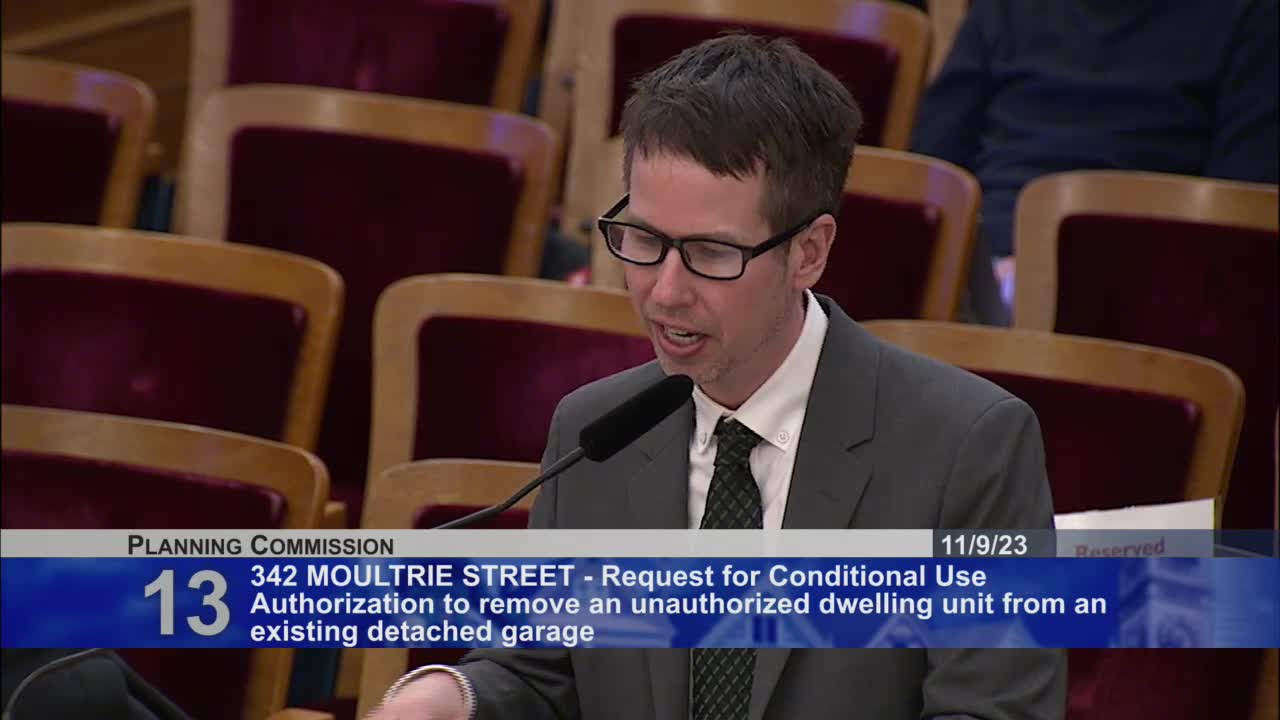San Francisco Commissioners Approve Conditional Use for Landmark Housing Project on Sacramento Street
November 09, 2023 | San Francisco City, San Francisco County, California
This article was created by AI summarizing key points discussed. AI makes mistakes, so for full details and context, please refer to the video of the full meeting. Please report any errors so we can fix them. Report an error »

In a pivotal meeting held at San Francisco City Hall, city officials deliberated on two significant projects that could reshape local neighborhoods and address housing needs. The discussions centered around conditional use authorizations for a residential project in the Bernal Heights neighborhood and an expansion of the Nob Hill Cafe, both reflecting the city's ongoing struggle with housing affordability and urban development.
The first project, located at 342 Moultrie Street, involves the removal of an unauthorized dwelling unit from a garage to revert the structure back to its original use. The project sponsor, a retired general contractor, shared his personal journey of saving the property from condemnation and the challenges he faced in legalizing the unit. Despite a revised cost estimate for legalization dropping to $379,552, the sponsor argued that the financial burden of compliance would jeopardize his retirement income, potentially forcing him to sell the property. The commission ultimately approved the project, emphasizing the need for community liaison conditions to ensure ongoing communication with local residents.
Meanwhile, the Nob Hill Cafe, a neighborhood staple for over three decades, sought to expand into an adjacent vacant retail space previously occupied by a dry cleaner. The owners highlighted the impact of the COVID-19 pandemic on their business and the changing demographics of the neighborhood, which now includes a younger population unfamiliar with the cafe's legacy. The expansion aims to create a dedicated takeout area, enhancing the cafe's viability in a post-pandemic landscape. The commission unanimously approved the expansion, recognizing its potential to revitalize the area and support a long-standing local business.
Both projects underscore the city's commitment to balancing development with community needs. As San Francisco grapples with a housing crisis, these discussions reflect a broader trend of adapting existing structures and businesses to meet the evolving demands of residents while preserving the character of its neighborhoods. The outcomes of these projects may serve as a blueprint for future developments in the city, highlighting the importance of thoughtful planning and community engagement in urban growth.
The first project, located at 342 Moultrie Street, involves the removal of an unauthorized dwelling unit from a garage to revert the structure back to its original use. The project sponsor, a retired general contractor, shared his personal journey of saving the property from condemnation and the challenges he faced in legalizing the unit. Despite a revised cost estimate for legalization dropping to $379,552, the sponsor argued that the financial burden of compliance would jeopardize his retirement income, potentially forcing him to sell the property. The commission ultimately approved the project, emphasizing the need for community liaison conditions to ensure ongoing communication with local residents.
Meanwhile, the Nob Hill Cafe, a neighborhood staple for over three decades, sought to expand into an adjacent vacant retail space previously occupied by a dry cleaner. The owners highlighted the impact of the COVID-19 pandemic on their business and the changing demographics of the neighborhood, which now includes a younger population unfamiliar with the cafe's legacy. The expansion aims to create a dedicated takeout area, enhancing the cafe's viability in a post-pandemic landscape. The commission unanimously approved the expansion, recognizing its potential to revitalize the area and support a long-standing local business.
Both projects underscore the city's commitment to balancing development with community needs. As San Francisco grapples with a housing crisis, these discussions reflect a broader trend of adapting existing structures and businesses to meet the evolving demands of residents while preserving the character of its neighborhoods. The outcomes of these projects may serve as a blueprint for future developments in the city, highlighting the importance of thoughtful planning and community engagement in urban growth.
View the Full Meeting & All Its Details
This article offers just a summary. Unlock complete video, transcripts, and insights as a Founder Member.
✓
Watch full, unedited meeting videos
✓
Search every word spoken in unlimited transcripts
✓
AI summaries & real-time alerts (all government levels)
✓
Permanent access to expanding government content
30-day money-back guarantee

